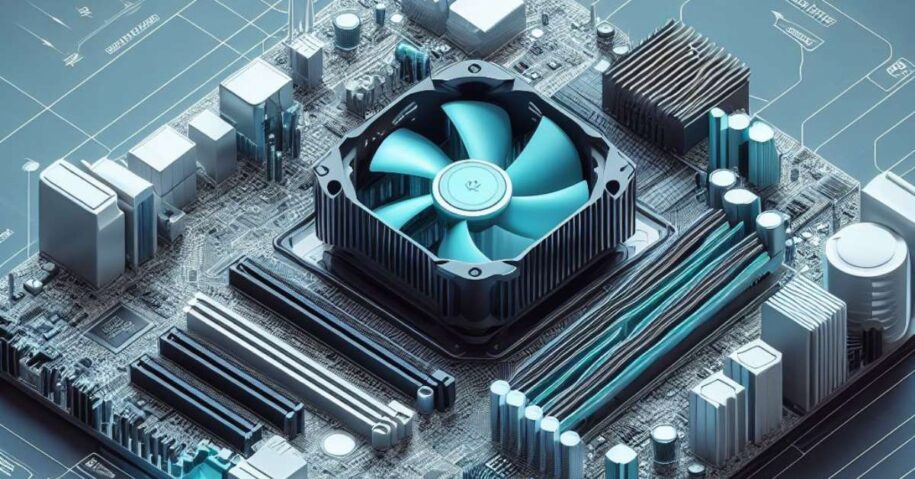
Your PC fans must be appropriately aligned for optimum system temperature and performance. Inadequate fan alignment can cause components to overheat and possibly experience thermal throttling, which can negatively impact the performance of your computer.
It can also result in more dust building within your PC, which could shorten its lifespan. The type of CPU cooler you have and how the airflow is set up in your entire system will determine which way the CPU fan should be pointed.
CPU Tower Cooler:
Horizontal Orientation:
If your CPU cooler is tower-style, the fan should generally face the case’s exhaust fan at the back. With this configuration, the CPU cooler can efficiently dissipate heat by pulling cool air from the front of the case, pushing it through the heatsink, and pushing hot air toward the exhaust fan at the back.

Vertical Orientation:
It may make sense to have the CPU cooler’s fan facing upward or downward, depending on your motherboard configuration and the orientation of the heatsink. Ensuring that the cooler’s design and airflow direction are in sync is essential to disperse heat effectively.

All-in-One Liquid Cooler (AIO):
The heatsink and fans can be placed using an all-in-one liquid cooler (AIO). The fans should generally be configured as exhaust, which means they should draw air through the heatsink and push it out of the case. The fans should be installed on the side of the heatsink that faces away from the CPU in this setup.
In some circumstances, it is also possible to mount the fans in a “pull” arrangement, which places them on the other side of the heatsink. This configuration is less typical and may have slightly different cooling capabilities.
The goal is to provide a consistent and effective flow of cool air into the CPU cooler and the expulsion of hot air from the casing. Additionally, review the manufacturer’s guidelines and recommendations for your particular CPU cooler model since they may contain detailed instructions on positioning the fans for the best cooling.

Do PC fans’ directions matter?
It does, indeed. When building a computer, many PC builders frequently forget to consider the orientation of the PC fans. During my testing I have observed that correctly oriented CPU and case fans offer several advantages, including:
Lower Motherboard Temperature:
By adequately positioning the CPU and case fans, the system efficiency can be increased by lowering the motherboard temperature.
Effective Airflow:
In addition to how they are used, internal components’ temperatures are also influenced by airflow and internal air pressure. Lower component temperatures are maintained via proper fan alignment, ensuring that cool air is brought in and heated air is efficiently evacuated.
The primary situations of air pressure inside a computer case need to be taken into consideration:
Positive Air Pressure:
Positive air pressure is produced when the number of intake fans exceeds the number of exhaust fans. Keeping the interior clean pushes air to enter the system primarily through dust filters.
Negative Air Pressure:
When there are more exhaust fans than intake fans, the opposite happens, creating negative air pressure. This can cause air from unfiltered openings to be drawn in, potentially causing more dust to accumulate.
Neutral Air Pressure:
This pressure is created when there are an equal number of intake and exhaust fans, and it may not affect dust buildup.
Sustaining system performance, temperature control, and cleanliness dramatically depends on the orientation of fans. A more effective and durable PC can be obtained by paying attention to fan alignment and airflow issues.
Frequently Asked Questions
Can you install the CPU fan on the opposite side of the heatsink, pulling air through it rather than pushing it?
This is referred to as a “pull” setup. While it can be done, it is less effective than a “push” design since it does not efficiently cool the CPU. For improved cooling performance, the “push” setting is recommended.
Should the CPU fan face up or down?
The airflow architecture of your case determines the direction of the CPU fan (up or down). If your case has decent airflow and an exhaust fan near the CPU, it’s usually better to turn the CPU fan upward, forcing hot air out of the case. If the case lacks good ventilation or if you have a top-mounted power supply that may interfere with the airflow of the CPU fan, facing the CPU fan downward can help pull in cooler air from outside the case.
Should I install more case fans to improve CPU cooling?
Additional case fans can increase overall airflow and CPU cooling. It’s customary to have intake fans at the front of the case to bring in cool air and exhaust fans at the back and top to evacuate heated air. Case fans that are appropriately positioned might help supplement the CPU fan’s cooling efforts.
How to Determine the Correct CPU Fan Direction?
You can use the following ways to identify the proper direction for mounting it:
Most CPU fans have arrow markings to show the airflow direction. Install the fan with the arrow pointing away from the CPU.
If your CPU fan lacks directional arrows, it most likely includes a circular sticker on one side that displays brand and model information. Orient the fan so that the side with the sticker faces up and the CPU is on the other side of the fan.
Without directional markings and stickers on the CPU fan, you can establish the correct orientation by analyzing the geometry of the fan blades. Install the fan with the convex side towards the CPU, ensuring that air is removed from the concave side.
Can you replace the CPU’s air cooler with a liquid cooler?
Yes, liquid coolers (all-in-one) can be used instead of standard air coolers. They are made up of a water block, a radiator, and fans. They can provide outstanding cooling performance and are frequently used in overclocking and high-performance systems. They may be more expensive and require professional installation.









